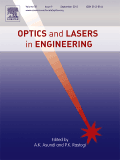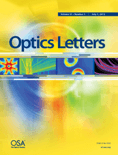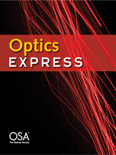
OPTICS AND LASERS IN ENGINEERING
Scope & Guideline
Harnessing Light for Engineering Excellence
Introduction
Aims and Scopes
- Optical Measurement Techniques:
Research on various optical measurement techniques, including digital holography, interferometry, and optical coherence tomography, aimed at enhancing precision and accuracy in engineering applications. - Laser Technology:
Explorations of laser technologies and their engineering applications, including laser machining, welding, and diagnostics. This encompasses the development of novel laser systems and methodologies. - Imaging and Sensing:
Innovative imaging techniques, such as 3D imaging, hyperspectral imaging, and advanced microscopy methods that utilize optics for enhanced sensing capabilities in various fields, including biomedical engineering and materials science. - Computational Techniques in Optics:
The integration of computational methods, including machine learning and deep learning, for improving optical systems, image processing, and data analysis in engineering applications. - Metasurfaces and Advanced Optical Materials:
Research on the design, fabrication, and application of advanced optical materials and metasurfaces, focusing on their unique properties for manipulating light and enhancing optical functionalities. - Interdisciplinary Applications:
Studies that bridge optics with other engineering fields, such as mechanical, civil, and biomedical engineering, demonstrating the versatile applications of optical methods in solving complex engineering challenges.
Trending and Emerging
- Integration of Machine Learning:
There is a significant increase in the application of machine learning and artificial intelligence techniques to optimize optical systems, enhance image processing, and automate data analysis. - Advanced Imaging Techniques:
Emerging trends in high-resolution, multi-dimensional, and hyperspectral imaging methods are gaining traction, particularly for biomedical applications and materials characterization. - Optical Metasurfaces:
Research on metasurfaces and their applications in manipulating light at the nanoscale is on the rise, showcasing innovative approaches to optical design and functionality. - Real-Time Measurement Systems:
A focus on developing real-time optical measurement systems that can capture dynamic phenomena, addressing the need for speed and accuracy in various engineering applications. - Hybrid Optical Systems:
Increased interest in hybrid systems that combine traditional optical methods with digital and computational techniques to improve measurement capabilities and expand application areas. - Sustainable and Green Technologies:
Emerging research themes include the development of sustainable optical technologies and methods aimed at reducing environmental impact, such as energy-efficient laser systems and eco-friendly materials.
Declining or Waning
- Traditional Optical Systems:
There has been a noticeable decrease in research focused solely on conventional optical systems and setups without integration of advanced technologies or computational methods. - Basic Laser Applications:
Topics related to basic laser applications, such as simple laser cutting and engraving techniques, have been less frequently addressed, possibly due to the maturation of these technologies. - Static Measurement Methods:
Static measurement methods, which do not incorporate dynamic or real-time capabilities, are becoming less common as research increasingly favors dynamic and adaptive measurement techniques. - Low-Resolution Imaging Techniques:
Research focusing on low-resolution imaging methods has declined, as there is a stronger emphasis on high-resolution and super-resolution techniques enabled by advanced optics and computational methods.
Similar Journals

OPTICS COMMUNICATIONS
Shaping Tomorrow's Technologies with LightOptics Communications, published by Elsevier, is a prestigious international journal that focuses on the dynamically evolving fields of optics and photonics. With its ISSN 0030-4018 and E-ISSN 1873-0310, this journal has made significant contributions to the fields of Atomic and Molecular Physics, Electrical and Electronic Engineering, Electronic, Optical and Magnetic Materials, and Physical and Theoretical Chemistry, consistently ranking in the Q2 quartile across these categories for 2023. The journal, based in the Netherlands, is recognized for its rigorous peer-review process and aims to publish high-quality research articles that advance knowledge and applications in optical communication technologies. Although it operates under a subscription model, the insightful research published here plays an essential role in informing the work of researchers, professionals, and students alike. With a history dating back to 1969 and spanning well into 2025, Optics Communications remains a crucial resource for cutting-edge developments in optics, catering to a global audience dedicated to innovation in this pivotal science.

APPLIED PHYSICS B-LASERS AND OPTICS
Bridging Theory and Practice in Laser PhysicsApplied Physics B - Lasers and Optics, published by Springer Heidelberg, is a renowned journal in the field of applied physics, particularly focusing on lasers and optical technologies. With a solid impact factor, this journal has established itself as a significant source of cutting-edge research, contributing to advancements in both theoretical and practical aspects of the discipline. The journal is indexed in Scopus, boasting a commendable rank of #24 out of 81 in the category of Physics and Astronomy (miscellaneous), reflecting its reputation and the quality of published work. Since its inception in 1994, Applied Physics B has covered a wide array of topics, catering to researchers, professionals, and students engaged in the exploration of innovative optical phenomena and laser applications. This journal not only disseminates vital knowledge but also fosters interdisciplinary collaboration, making it an essential resource for those seeking to stay at the forefront of research in lasers and optics.

OPTICS LETTERS
Pioneering Innovations in Optical ScienceOPTICS LETTERS is a premier academic journal published by the Optica Publishing Group, dedicated to advancing the field of optics and photonics. Since its inception in 1977, it has maintained a strong reputation for publishing high-impact research, holding a distinguished Q1 category ranking in Atomic and Molecular Physics, as well as Optics, making it a vital resource for researchers and professionals alike. With an impressive Scopus rank of #55 out of 224 in its field, OPTICS LETTERS continues to shape the discourse and innovation in optical science. Authors benefit from its extensive international reach, while readers gain access to cutting-edge studies that address both theoretical and applied aspects of optics. Although the journal currently does not offer open access options, its rigorous peer-review standards ensure that every publication meets the highest academic criteria, making it an essential journal for anyone looking to stay at the forefront of optical research.

OSA Continuum
Empowering Open Access to Cutting-Edge ResearchOSA Continuum, published by the Optica Publishing Group, is a distinguished open access journal dedicated to advancing research in the realms of Atomic and Molecular Physics, Optics, and Electronic and Electrical Engineering. Since its inception in 2018, this journal has rapidly positioned itself as a significant platform for disseminating cutting-edge findings, achieving impressive Scopus rankings with a 61st percentile in Electrical and Electronic Engineering and 57th in Atomic and Molecular Physics. Based in the United States, the journal not only promotes scholarly dialogue among researchers and professionals but also plays a crucial role in bridging theoretical advances with practical applications in optical and material sciences. Its open access format ensures broader visibility and accessibility of research outputs, fostering innovation and collaboration across disciplines. With its ongoing commitment to excellence, OSA Continuum is crucial for anyone involved in these dynamic fields.

LASER PHYSICS
Exploring the Frontiers of Optics and EngineeringLASER PHYSICS is a premier academic journal published by IOP Publishing Ltd, dedicated to the exploration and advancement of fundamental and applied research in the fields of Atomic and Molecular Physics, Optics, Condensed Matter Physics, Industrial and Manufacturing Engineering, and Instrumentation. Since its inception in 1996, the journal has been a vital resource for researchers and professionals, contributing significantly to the collective understanding of laser technology and its applications. With a consistent Q3 ranking across several sub-disciplines in the 2023 categories, LASER PHYSICS is recognized for its rigorous peer-reviewed articles that push the boundaries of current knowledge. Although primarily subscription-based, the journal aims to disseminate high-quality research to enhance the scientific community's collaboration. As the journal continues to shape the future of laser science until 2024 and beyond, it stands as an essential platform for both emerging and established scholars seeking to publish innovative findings in this dynamic field.

PhotoniX is a premier open-access journal published by SPRINGERNATURE in Germany, dedicated to the fields of Atomic and Molecular Physics, Optics, and Electrical and Electronic Engineering. Launched in 2020, this journal has swiftly established itself as a key resource within the scientific community, achieving impressive rankings, notably being placed in the Q1 quartile across its categories in 2023. With its Scopus ranks highlighting its excellence—2nd in Engineering (Miscellaneous), 9th in Electrical and Electronic Engineering, and 6th in Atomic and Molecular Physics—PhotoniX serves as a critical platform for researchers to disseminate their findings. With an emphasis on broadening access to cutting-edge research, the journal offers a valuable opportunity for engagement with contemporary advancements in the fields it covers. Researchers, professionals, and students can benefit significantly from its contents, contributing to the collective knowledge in these vital areas of science and technology.

OPTICS EXPRESS
Your Gateway to Cutting-Edge Optics DiscoveriesOPTICS EXPRESS is a premier peer-reviewed journal published by the Optica Publishing Group, specializing in the rapidly evolving fields of Atomic and Molecular Physics and Optics. With an impressive Q1 ranking in its category and positioned in the 75th percentile among leading journals in Physics and Astronomy, OPTICS EXPRESS serves as a vital platform for disseminating innovative research findings. Since its inception in 1997 and transitioning to Open Access in 1998, the journal has ensured that groundbreaking scientific contributions are accessible to a global audience, fostering collaboration and advancement in optical science. Additionally, with annual publications converging from 1997 to 2024, this journal not only tracks the latest advancements but also shapes the future landscape of optics research. Whether you are a seasoned researcher, a dedicated professional, or a passionate student, OPTICS EXPRESS offers a wealth of knowledge and a commitment to excellence in the optics community.

Optica Pura y Aplicada
Exploring the Depths of Atomic and Molecular PhysicsOptica Pura y Aplicada, published by the SOC ESPANOLA OPTICA, stands as a vital platform for the dissemination of cutting-edge research in the fields of Atomic and Molecular Physics, Optics, and related engineering disciplines. Established in Spain, this journal aims to foster the advancement of knowledge in optical science and technology by providing a rigorous peer-reviewed publication outlet for scholars, researchers, and practitioners. Despite being categorized in the Q4 quartile across multiple domains, including Engineering and Materials Science, the journal remains committed to contributing meaningful insights and advancements within its scope. With an ISSN of 0030-3917 and an E-ISSN of 2171-8814, the journal effectively reaches a global audience eager to explore innovative applications and theoretical developments in optics and materials science. Researchers and professionals alike will find in Optica Pura y Aplicada a valuable resource for enriching their understanding and practices in an ever-evolving field, fostering collaborations and promoting research growth until its converged conclusion in 2024.

LASER PHYSICS LETTERS
Pioneering Research in Laser ApplicationsLASER PHYSICS LETTERS is a prestigious peer-reviewed journal published by IOP Publishing Ltd in the United Kingdom, focusing on the burgeoning field of laser physics and its applications. With an ISSN of 1612-2011 and an E-ISSN of 1612-202X, this journal stands at the intersection of innovative research and practical applications, addressing diverse topics within the realms of Instrumentation and Physics and Astronomy. Recognized for its impactful contributions, it boasts a ranking within the Q3 quartile for both relevant categories as of 2023, reflecting its steady rise and commitment to advancing knowledge in the area. Researchers and practitioners are encouraged to explore its content and contribute to the ongoing discourse that shapes the future of laser technologies. While LASER PHYSICS LETTERS does not currently offer open access options, its rigorous selection criteria ensure that published work is of the highest quality, positioning it as a vital resource for anyone engaged in laser science and engineering.

Journal of Optics-India
Empowering Scholars to Transform Optical ScienceThe Journal of Optics-India, published by SPRINGER INDIA, serves as a vital platform dedicated to advancing research in the field of optics, focusing on topics in both atomic and molecular physics. With an ISSN of 0972-8821 and an E-ISSN of 0974-6900, the journal has been a consistent contributor to the field since its inception in 1996 and continues to thrive with its anticipated convergence through 2024. Although currently classified in Q3 of the 2023 category quartiles, the journal actively seeks to elevate its standing within Scopus rankings in physics and astronomy, where it holds a rank of 143/224, indicating significant opportunities for growth and research impact. The Journal of Optics-India is committed to fostering innovative research and providing scholars and practitioners with access to cutting-edge findings, thereby enhancing global conversations around optics and its vast applications. As a reliable source for researchers, professionals, and students alike, the journal emphasizes quality contributions that shape the future of optical science.